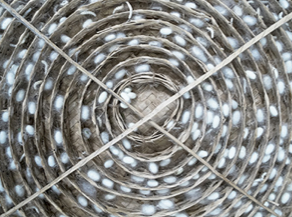Focusing deeply on one subject opens up millions of doors.
My focus, being the life of silkworms as sculptural form, constantly hunting for a good photo, I know one has to be there, in the centre of where the chosen subject is possible to catch. I got the chance and left for India. My observation of sericulture took place in Karnataka, India, one of the biggest silk production centers in India. We, my mother and I, drove to far remote villages to visit sericulture farmers. In India sericulture is a tradition as well as a living culture.
Producing silk is a farm-based labour system. It provides income and employment to the rural poor with small land-holdings. It became evident that sericulture villages did not look as poor and run down as other villages. The benefit – cost ratio in sericulture is the highest among agricultural crops. We began our research on silk production by visiting the Central Sericultural Research & Training Institute in Mysore.
It was here I saw, how silk cocoons were stripped off, tumbling around in hot water and thousands of cocoons lying on metal grid frames, waiting for their fate. We asked several people about names on villages, where the cultivation of larvae could be seen. It turned out to be a job of a detective. We drove and visited several places in vain – either there was only an empty hangar or some remnants of tools. Finally a farmer helped us setting up a meeting with the sericulture extension officer Mr. Krishna, who found my interest extremely enchanting. He had never before had a visit from somebody like us, who wanted to visit farmers and also eventually purchase cocoons.
Mr. Krishna knew everybody and soon we found ourselves in another house in Nagar with thousands of A4 cardboards onto which silkworm eggs were glued. Female moths lay between 150 – 400 eggs, sometimes up to 1000 eggs. Farmers come and pick up eggs from this house to bring them to their mulberry trees in the villages. On shelves were cocoons everywhere. I was lucky to purchase half a kg; they do not weigh anything, so it turned out to be a lot. We visited a farmer, who in his large hangar had enormous shelves filled with mulberry leaves on which millions of larvae were feeding loudly. Outside, on huge cocoon storage trays, made of woven bamboo, circular shelf systems showed a pure white landscape of oval white satellites.
My focus, being the life of silkworms as sculptural form, constantly hunting for a good photo, I know one has to be there, in the centre of where the chosen subject is possible to catch. I got the chance and left for India. My observation of sericulture took place in Karnataka, India, one of the biggest silk production centers in India. We, my mother and I, drove to far remote villages to visit sericulture farmers. In India sericulture is a tradition as well as a living culture.
Producing silk is a farm-based labour system. It provides income and employment to the rural poor with small land-holdings. It became evident that sericulture villages did not look as poor and run down as other villages. The benefit – cost ratio in sericulture is the highest among agricultural crops. We began our research on silk production by visiting the Central Sericultural Research & Training Institute in Mysore.
It was here I saw, how silk cocoons were stripped off, tumbling around in hot water and thousands of cocoons lying on metal grid frames, waiting for their fate. We asked several people about names on villages, where the cultivation of larvae could be seen. It turned out to be a job of a detective. We drove and visited several places in vain – either there was only an empty hangar or some remnants of tools. Finally a farmer helped us setting up a meeting with the sericulture extension officer Mr. Krishna, who found my interest extremely enchanting. He had never before had a visit from somebody like us, who wanted to visit farmers and also eventually purchase cocoons.
Mr. Krishna knew everybody and soon we found ourselves in another house in Nagar with thousands of A4 cardboards onto which silkworm eggs were glued. Female moths lay between 150 – 400 eggs, sometimes up to 1000 eggs. Farmers come and pick up eggs from this house to bring them to their mulberry trees in the villages. On shelves were cocoons everywhere. I was lucky to purchase half a kg; they do not weigh anything, so it turned out to be a lot. We visited a farmer, who in his large hangar had enormous shelves filled with mulberry leaves on which millions of larvae were feeding loudly. Outside, on huge cocoon storage trays, made of woven bamboo, circular shelf systems showed a pure white landscape of oval white satellites.




No comments:
Post a Comment